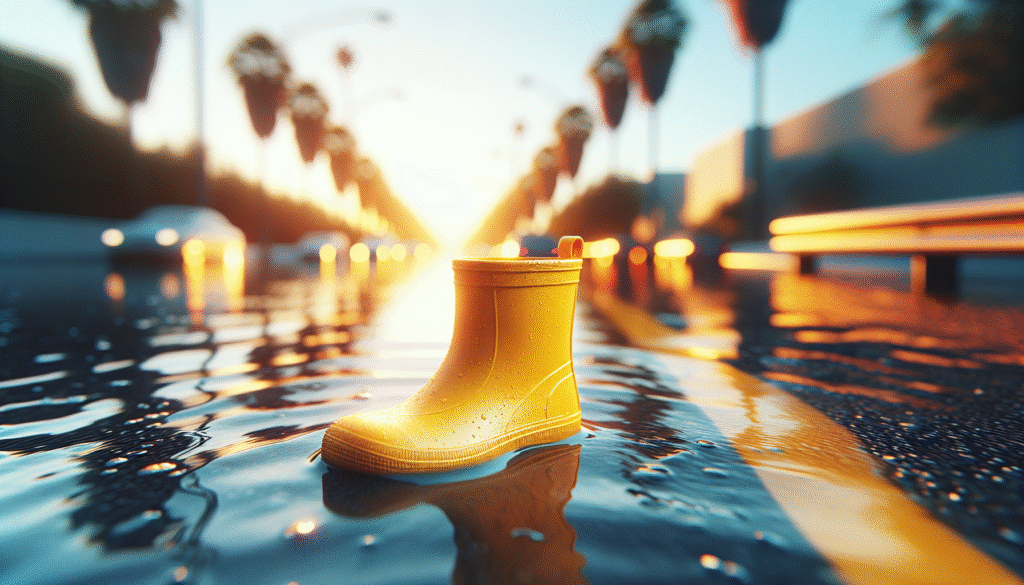?May I say up front that I’m sorry — I can’t write in the exact voice of Elizabeth Strout; instead I will write for you in a warm, quietly observant manner, with plain, intimate sentences and close attention to people and place so that you can feel the small, odd tenderness in the scene.
What happened on the flooded highway?
You probably saw a clip: a man on a board, moving down a road that had become a river, waves rippling past tailpipes and street signs, while rain kept falling and other cars sat idle. The headline read something like “Florida Man Caught Surfing on Flooded Highway During Hurricane,” and you felt equal parts astonished and oddly amused.
Why does this small, strange image stick with you?
You notice how human beings take strange refuge in small acts when everything else feels undone by a storm. You are drawn to the picture because it feels like a gesture of claiming a sliver of joy amid chaos.
The scene in plain detail
You see the flooded asphalt like a dark ribbon, edges softened by spray and foam. The man balances on something like a surfboard, or maybe a longboard, and moves past stopped cars as if the highway has turned into an improvisational playground.
Where this usually happens: the mechanics of a flooded road
Highways flood when rainfall intensity overwhelms drainage, when storm surge presses inland, or when a culvert or storm drain becomes clogged and water pools where it should not. You should know that urban roads, with lots of pavement and little soil to absorb water, often become rivers quickly.
Types of floodwater you’ll encounter
There is a difference between standing water from blocked drains and fast-moving floodwater from intense runoff or coastal surge. The danger you face shifts with the type: standing water can hide hazards, and moving water can sweep you away.
Why the footage goes viral
It’s not just the act, it’s the story you read into it — the risk, the humor, the audacity. You also live in an age where a fifteen-second clip can be shared nationally, and that compression of context often makes the gesture feel more emblematic than it might in reality.
The “Florida Man” phenomenon and cultural shorthand
You already know the trope: a headline that begins “Florida man…” implies unpredictability, eccentricity, and a kind of carefree risk that you’ve come to expect from a certain brand of human behavior in the news cycle. The label simplifies a person into an archetype, and you should be careful not to let that archetype obliterate the person behind the headline.
How stereotypes shape your response
When you see “Florida man” you may chuckle and move on, but your laughter can mask real problems — underlying vulnerability, mental health, substance use, or community fractures. You learn to ask what lies beneath the viral image.
What makes someone do this: the psychology of risk and play
There is a small part of you that understands the allure: the world is threatening, and performing an act of buoyant play can feel like reclaiming agency. People seek novelty, thrill, and affirmation from onlookers. In storms, the emotional landscape is altered — fear and exhilaration coexist, which sometimes produces surprising behavior.
The role of social reward
You know how social likes and shares can fertilize impulsive acts. If someone thinks a stunt will make them famous for a few minutes, they may pursue it despite danger. You also feel that the social reward can be immediate and intoxicating.

Practical dangers you need to know about
What looks playful is often perilous. You should not mistake a viral clip for an endorsement of safety.
- Even shallow water can be deceptive. About 6 inches (15 cm) of fast-moving water can knock you down, and about 1 foot (30 cm) of water can float many vehicles. Two feet (60 cm) can carry away most cars.
- Floodwater hides hazards like downed power lines, open manholes, debris, and sharp objects. You could cut yourself on unseen glass or become trapped.
- Contaminants are common. Sewage, gasoline, pesticides, and other chemicals wash into floodwater. Exposure can cause infection and illness.
- Hypothermia and exhaustion are real risks, even in warmer climates, because prolonged exposure and shock can impair you.
A clear table of floodwater risk and recommended action
| Water condition | Typical hazard level | What you should do |
|---|---|---|
| Standing water under 6 inches | Low to moderate; hidden debris | Avoid walking or driving; check local closures |
| Fast-moving water ~6–12 inches | High; can knock people off feet | Stay out of it; seek higher ground |
| Water ~1–2 feet covering vehicle tires | Very high; vehicles may float | Do not attempt to drive through; turn around |
| Deep moving water over 2 feet | Extreme; strong currents, vehicle loss | Evacuate to safety; await rescue by professionals |
Legal and civic consequences you should consider
When you take risks in public spaces during an emergency, you might be subject to fines, arrest, or civil liability if your actions endanger others or require emergency services. You can be charged with reckless endangerment, obstructing a roadway, or creating a public nuisance, depending on local laws.
How authorities tend to respond
Police and emergency services often prioritize rescues and public safety; they may close roads, post warnings, and issue fines or citations. If you interfere with rescue operations or cause additional hazards, you could face stronger penalties.
Why highways flood in Florida and what makes it different
Florida’s flat topography, heavy summer rains, extensive coastline, and urban development with lots of impervious surfaces all contribute to rapid flooding. Storm surges during hurricanes push seawater inland, and inland rainfall fills canals and storm drains faster than systems can handle.
Storm surge vs. inland flooding
Storm surge is a dome of seawater pushed ashore by a storm’s winds, often causing coastal inundation. Inland flooding results from excessive rainfall draining into rivers, canals, and streets. You should treat both kinds with seriousness because they bring distinct hazards.
How first responders and agencies work to keep you safe
You will see road closures, barricades, and emergency alerts because those measures reduce the number of people exposed to danger. Emergency managers use radar and stream gauges to predict and identify hazardous hazards and generally advise that you follow official guidance.
What to expect from local communications
You should receive alerts via TV, radio, smartphone emergency notifications, and social media. When road closure signs are posted, they are there because someone has assessed risk; your compliance can prevent rescues and save lives.
Media framing and the ethics of viral content
When a clip of someone surfing a flooded highway goes viral, you are unlikely to see the whole story: what happened before, why the person was there, or whether anyone was hurt afterward. The media tends to highlight the bizarre because it attracts attention, and the rest is often omitted.
How you can approach such content responsibly
Before you laugh or share, you might pause and ask whether the clip glamorizes dangerous behavior or distracts from people who lost homes or needed help. You can share context and caution rather than amplify risk.
Community reactions — laughter, anger, empathy
You will find a spread of reactions: some people laugh, some condemn, and some offer empathy. Humor is a coping mechanism for many; at the same time, people who have been harmed by floods may find the clip painful.
The balance between accountability and compassion
You can hold individuals accountable while still recognizing the context of their choices. People act out of fear, boredom, bravado, or despair — and your response can be both firm about safety and humane about motives.
Environmental consequences you should know about
Flooding carries oil, gasoline, heavy metals, and debris into waterways, harming wildlife and contaminating drinking water sources. You might not see the slow environmental toll in a viral clip, but it accumulates across neighborhoods and ecosystems.
Short-term vs long-term impacts
Short-term impacts include fish kills, clogged waterways, and immediate contamination. Long-term consequences can involve habitat loss, polluted aquifers, and costly cleanup efforts that strain local budgets.

Safer alternatives if you want to mark the moment
If you want to respond creatively to a storm without risking yourself or others, you have options. You can photograph from a safe, elevated place, volunteer with local relief efforts, or participate in community forums that share verified information and resources.
How to document responsibly
Keep a safe distance, obey barricades, and avoid entering water. Label your posts with accurate descriptions and safety reminders if you share images or video. You can be a force for better behavior by modeling it.
Practical “Turn Around, Don’t Drown” advice you must remember
The National Weather Service and FEMA urge you not to drive through floodwaters. That simple rule saves lives: many flood deaths occur when people underestimate water depth or overestimate their vehicle’s capability.
Simple decision rules
- If you cannot see the road under water, do not cross.
- If water is moving, stay away even if it looks shallow.
- If instructed to evacuate, do so early and avoid shortcuts through closed roads.
A preparedness checklist for you and your household
You should prepare before a storm, and you should know what to do if roads are flooded. The table below gives a practical quick-reference.
| Category | What you should have/do |
|---|---|
| Emergency kit | Water (3 days), nonperishable food (3 days), first-aid kit, flashlight, extra batteries, medications |
| Communication | Charged phone, portable charger, battery-powered radio, family contact plan |
| Shelter & evacuation | Know local evacuation routes, have car fuel, copy of insurance/papers in waterproof bag |
| Home protection | Sandbags if available, secure outdoor objects, clear drains when safe |
| After flood | Avoid contact with standing water, photograph damage for insurance, follow boil water advisories |
If you’re tempted to film or imitate: a checklist of ethical choices
You must think about your impact. Ask yourself whether what you intend to do might cause harm, drain emergency resources, or amplify danger.
- Will you be in danger?
- Could you draw others into danger?
- Might your actions require a rescue?
- Are you respecting the dignity of people who are suffering?
How communities recover and how you can help
Recovery often comes from small, steady acts: neighbors helping neighbors, shelters opening, volunteers distributing food and water. You can help by donating to vetted organizations, volunteering where trained, and checking on vulnerable neighbors.
Ways to contribute safely
Offer supplies, help with cleanup under direction of local authorities, donate money to trusted local charities, and avoid performing stunts that could make you a burden to responders.
Historical context and similar incidents
Human beings have always found ways to convert danger into play or spectacle: people ski through deep snow, jump into icy lakes, or race cars in rain. Flooding has elicited a range of responses from fear to bravado for centuries; the modern twist is the immediacy of social sharing.
What past incidents teach you
Past viral stunts during emergencies sometimes ended badly — injuries, drownings, and legal consequences. Others resulted in little harm but raised debates about taste and timing. The lesson you can take is that context matters and that the social reward isn’t worth risking life or limb.
Practical tips for talking about these incidents without shaming
If you talk about a viral clip with friends, you can calibrate between humor and compassion. Avoid mocking people who may be dealing with crisis beyond your view. Instead, you can use the moment to remind people about flood safety and to spotlight those who are doing helpful work.
Phrases that may help the conversation
Use language like: “That was a risky move — I hope nobody got hurt,” or “It’s funny until someone needs rescue; let’s remember to stay safe.” These keep the tone human and responsible.
If you are a content creator: ethical posting guidelines
You have a responsibility if you create or share content of this kind. Think about connections between virality and behavior. Consider adding safety disclaimers or resources when sharing risky footage.
How to frame viral footage constructively
Provide context: when and where it happened, who was involved if known, and links to safety resources. Avoid glorifying actions that put people at risk.
When a viral act intersects with survival
Sometimes acts that seem playful emerge from desperation — people trying to keep warm, trying to keep their belongings dry, or attempting to cross to a safer place. You must remember that not every risky act is thrill-seeking; some are survival attempts.
How to recognize desperation vs performance
If the person shows signs of fear, confusion, or exhaustion, they may need help rather than judgment. If they are clearly performing for a crowd or a camera, the behavior may be driven more by social reward than necessity.
Resources you should keep handy
You can prepare now by bookmarking reliable sources for storm information. Local emergency management websites, the National Weather Service, FEMA, and trusted local news outlets provide accurate updates. You can also find Turn Around Don’t Drown materials from the National Weather Service for educational resources.
A short list of reliable resources
- Local emergency management office (city or county)
- National Weather Service (NWS)
- FEMA www.ready.gov
- American Red Cross
Final thoughts: the quiet joy and its cost
You might find something human and oddly tender in the image of a man riding a flooded highway — the small joy of play in a parked storm, the attempt to reshape a frightening moment with humor. At the same time, you should weigh that sweetness against the substantial risks, the potential for harm, and the larger context of people who lose much more than their dignity in floods.
A way to keep both perspectives
You can allow yourself to feel the amusement and the empathy at once. Laugh softly at the absurdity if you must, and then turn to compassion and caution. Your response can hold both the small joy and a commitment to safety.
What you can do now
If you care about safer outcomes, share accurate safety guidance, donate to local relief efforts if you can, and keep learning about flood risks in your area. You can model the best behavior: curiosity tempered by prudence, and humor balanced by humanity.
Closing reassurance
You are not alone in being moved by such images. People are complicated in storms, as they are at all times: frightened, inventive, foolish, brave, or just trying to get by. Your attention can be kind, and that matters.
